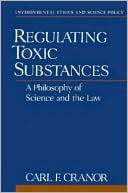Regulating Toxic Substances: A Philosophy of Science and the Law
Search in google:
The proliferation of chemical substances in commerce poses scientific and philosophical problems. The scientific challenge is to develop data, methodologies, and techniques for identifying and assessing toxic substances before they cause harm to human beings and the environment. The philosophical problem is how much scientific information we should demand for this task consistent with other social goals we might have. In this book, Cranor utilizes material from ethics, philosophy of law, epidemiology, tort law, regulatory law, and risk assessment, to argue that the scientific evidential standards used in tort law and administrative law to control toxics ought to be evaluated with the purposes of the law in mind. Demanding too much for this purpose will slow the evaluation and lead to an excess of toxic substances left unidentified and unassessed, thus leaving the public at risk. Demanding too little may impose other costs. An appropriate balance between these social concerns must be found. Justice requires we use evidentiary standards more appropriate to the legal institutions in question and resist the temptation to demand the most intensive scientific evaluation of each substance subject to legal action.
Introduction: Assessing Toxic Substances Through a Glass Darkly31The Scientific Background12Predicting Risks from Animal Bioassays13Background13Regulatory Science and Policy Choices15Normative Implications of the Scientific Uncertainties in Risk Assessment25Problems in the Statistics of Human Epidemiological Studies and Animal Bioassays29Discovering Risks29Practical Evidence-Gathering Problems30Theoretical Difficulties31Traditional Practices in Interpreting Epidemiological Studies39An Alternative to Traditional Practices40Clean Hands Science, Dirty Hands Public Policy40Professional Ethics42Public Policy Issues442Scientific Evidence in the Tort Law49Institutional Background49The Challenge to Present Evidentiary Procedures55Legal Issues57Arguments for the Scientific Standards Test60Arguments Against Competitor Views60Black's Proposal66A Common Conceptual Framework for Evaluating Scientific and Legal Burdens of Proof71An Alternative View783Joint Causation, Torts, and Administrative Law in Environmental Health Protections83Joint Causation and the Tort Law85Liability Rules for Causation85Proof of Causation90Administrative Law91No Moral or Policy Bars to Regulation when Joint Causation Obtains91The Case for Regulation of Toxic Substances when Joint Causation Obtains94Utilitarian Arguments95Justice Arguments97Other Considerations for Using Administrative Remedies994Scientific Procedures in Regulatory Agencies103Institutional Background104Major Laws Regulating Carcinogens104Premarket Regulatory Statutes104Postmarket Regulatory Statutes105Procedural Requirements107Substantive Statutory Requirements107Approaches to Risk Assessment in Regulatory Agencies109A Brief History of Agency Use of Risk Assessment109Current Agency Risk Assessment Practices113Two Unacceptable Approaches to Risk Assessment115The Complete and Accurate Science Approach116The Science-Intensive Approach116Shortcomings of Present and Recommended Practices129An Alternative Approach131Coping with Scientific Uncertainty131Mitigating the Demanding Evidentiary Standards of Science135Expediting Risk Assessment137Use of Tabulated TD[subscript 50]s for Most Sensitive Sites and Species138Use of Expedited Linearized Multistage Default Procedures141The Virtues of Expedited Procedures141Making Public Policy on Expedited Risk Assessments Through the Agencies and Courts1475Epistemic and Moral Justification152Epistemic Justification153Moral Justification157Principles Implicit in the Occupational Safety and Health Act160Philosophical Theories of Distribution163Utilitarianism163The Daniels-Rawls Theory of Health Care Protection168The Attraction of Distributively Sensitive Theories175Notes179Appendix A Uncertainties in Carcinogen Risk Assessments221Appendix B Cancer Potency Estimates of CDHS and EPA222Appendix C Relative Risk as a Function of Alpha and Beta Values225Appendix D Statutes Authorizing Regulation of Carcinogens229Appendix E Derivation of TD[subscript 50] Potency Values230Bibliography231Index243








